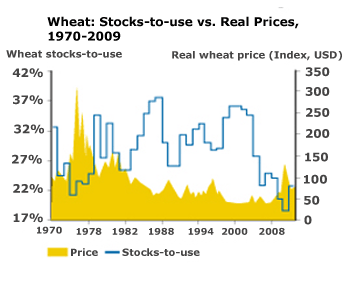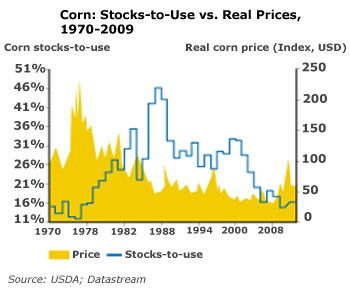There is some mind-bending stuff percolating in the agricultural markets. In fact, the setting recalls the one that set off the big move in oil prices in recent years...Hat Tip Chain: Market Folly directed us to Commodity Bull Market who writes:
"Investing in agriculture today will be like investing in the oil sector in 2001-2002," writes Mark McLornan in the May issue of Marc Faber's Gloom Boom & Doom Report. McLornan runs a fund that invests in farmland. Some of his on-the-ground observations confirm many of the things I've been telling my readers for the past several years.
As for likening agriculture today to oil in 2001-2002, an investor's pulse quickens. We all know the great run oil stocks had as the price of oil sprinted from under $30 to a peak of $143 per barrel. Investors made hundreds-of-percent gains – even thousands-of-percent gains. What most investors forget is that oil prices halved from 2000 to the bottom in 2001 before the great run-up. The same sort of setup seems to exist in agriculture.
In agriculture, most commodities are half or so of their June 2008 highs. This is the pause that refreshes. All the kindling that turned them ablaze in 2008 – rice was trading for $1,000 per ton – are still in place for a much bigger surge this time around.
"I believe one should look for areas in which there is underinvestment, low leverage and undersupply," McLornan continues. "Agriculture is one of the very few sectors globally that currently face supply shortages." The biggest reason to get excited about agriculture is to look at the stocks-to-use ratio, which measures how much supply is on hand versus how much we use.
Higher ratios imply a fully supplied market. Lower ratios hint at possible shortages. McLornan provides two charts that show how the stocks-to-use ratios look for wheat and corn, respectively.
The Cupboard Is Almost Bare
Those ratios today are lean. You have to go back to the 1970s to find inventories this low....MORE
...Investing in grains is actually pretty easy - when supplies are low, and prices are low, you know prices should eventually go up. Then, at some point, high prices spur enough new supply onto the market that prices come down. Ideally, that's when you go short!You'll notice from the charts that grain stocks and prices move in fairly long cycles - about 15 to 20 years in length. It takes time to bring new supply online, to replenish stocks...ultimately to rebalance the supply/demand situation....
Here's the ten second tutorial on Ag cycles:
The Hog Cycle
Um, folks, um, maybe we should start thinking about rebuilding our grain reserves.
And:
A Black Swan in Food
The Hog Cycle
We also have an interest in grain reserves. From April '08:No not Harley-Davidson, although I imagine some econ grad student has written the paper.
Wheat and hogs are two commodities with long price series. We mentioned the hog cycle back in January:The hog price series is one of the longest we have records for, back to the 1200's. The cycle is:
slaughter begets scarcity begets higher prices begets breeding begets over-supply begets slaughter. It's been going on for a while.
Today Professor Mankiw tips us to a government subsidized variation:
Um, folks, um, maybe we should start thinking about rebuilding our grain reserves.
And:
A Black Swan in Food
...As a follow-up to the PDO/food thoughts that ended the post below and the crop progress report yesterday, we have this snip from Minyanville:From "Climate Change and the Pacific Decadal Oscillation":
...Donald Coxe, chief strategist of Harris Investment Management and one of my favorite analysts, spoke at my recent Strategic Investment Conference. He shared a statistic that has given me pause for concern as I watch food prices shoot up all over the world.
North America has experienced great weather for the last 18 consecutive years, which, combined with other improvements in agriculture, has resulted in abundant crops. According to Don, you have to go back 800 years to find a period of such favorable weather for so long a time....
...Here's the monthly PDO chart.And from January this year "Industrialization of China increases fragility of global food supply":
You might want to look up the word famine. And store a couple tons of wheat in a vermin proof room. The risk of a major crop failure somewhere in the world over the next ten years just went up. My best guess (wild-ass variant) would be northeastern Russia/Ukraine. Which could get interesting:...With the international financial institutions working on a slow track, countries have been cutting their own deals. Ukrainian President Viktor Yushchenko said on Tuesday that he had agreed to let Libya grow wheat on 247,000 acres of land in the Ukraine. In exchange, Libya promised to include the former Soviet republic in construction and gas deals.
-Wall Street Journal
April 14, 2008 Page 1A
This is something that is truly concerning. Policymakers have to address the greater than trivial chance that there will be a major crop failure sometime in the next decade.
With grain prices down dramatically from last year's highs this would be a very good time to rebuild stocks of grain in storage. We've been beating this drum for a year, it's that serious.......Watch that Pacific Decadal Oscillation. A New York Times archive search for the term "crop failure" returns 1950 hits, with a preponderance of stories written during the cool phase of the PDO. With the interconnectedness of the world's grain markets, a failure anywhere would raise prices everywhere....
Yeah, we have an interest in this stuff.

